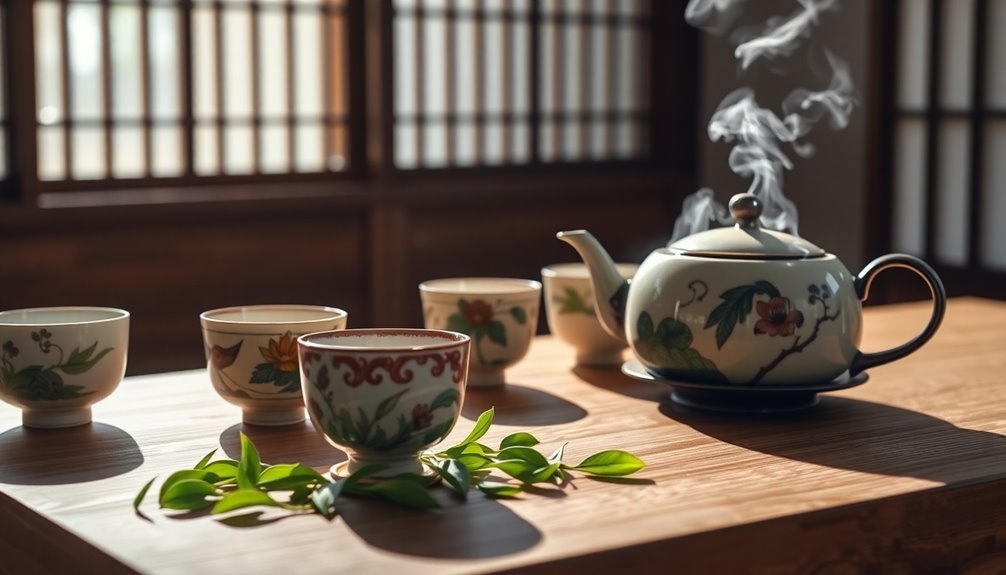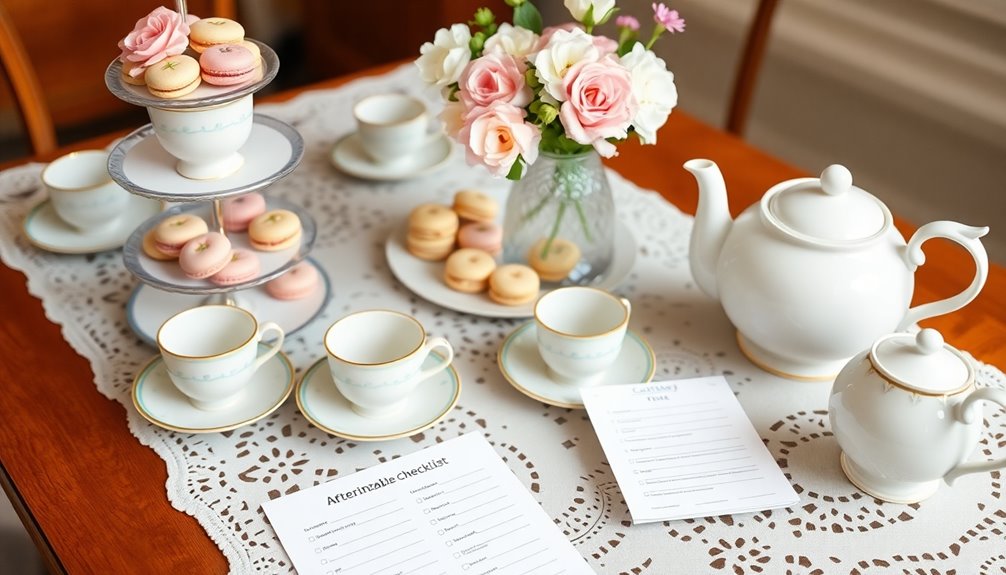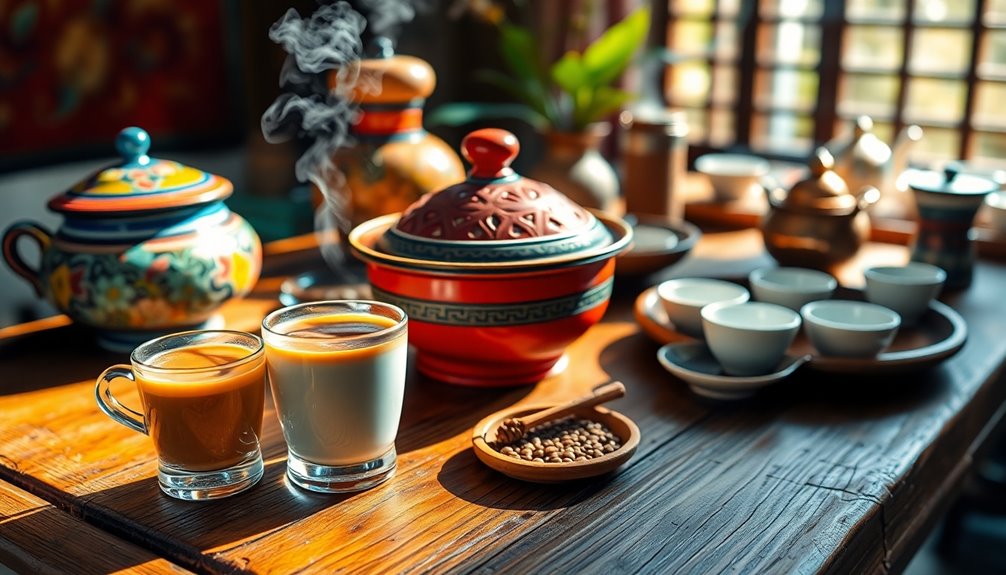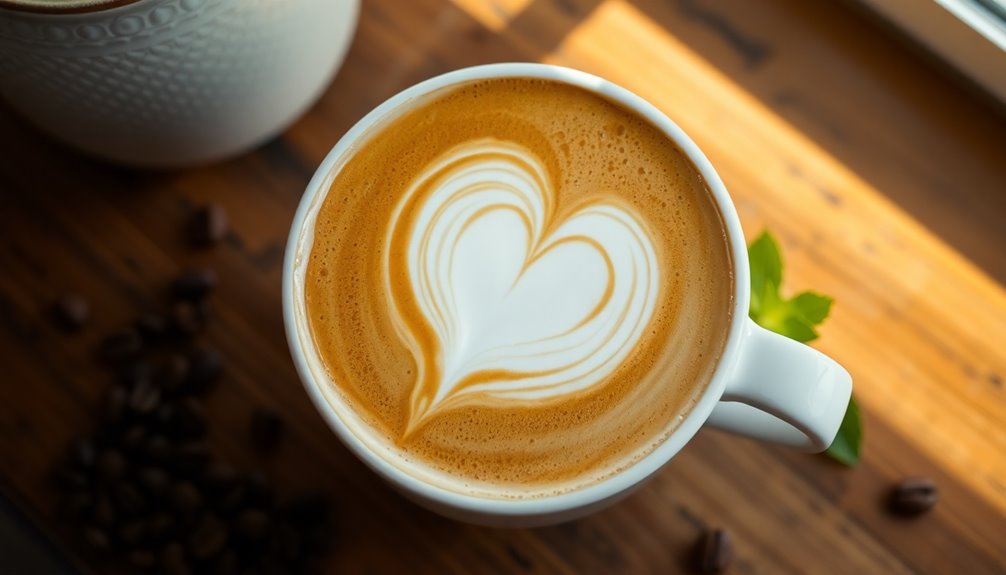Exploring Japanese teaware and its ceremonies offers a unique glimpse into a culture that values harmony and mindfulness. You'll find that each cup, like the yunomi or chawan, serves a specific purpose, enhancing the flavors of matcha and loose-leaf teas. The tea ceremony, known as chanoyu, is not just about sipping tea; it's a ritual that fosters connection and gratitude among participants. The beauty of the teaware lies in its craftsmanship and the philosophy of wabi-sabi, celebrating imperfections and simplicity. If you're keen to uncover more about the components and significance behind these exquisite traditions, there's plenty more to discover.
Key Takeaways
- Japanese teaware, including yunomi and chawan, enhances the experience of matcha and loose-leaf teas through thoughtful design and functionality.
- The tea ceremony, or chanoyu, embodies key principles of harmony, respect, purity, and tranquility, focusing on mindful tea preparation.
- Essential utensils like chasen, chashaku, and mizusashi work together to elevate the tea experience, reflecting meticulous craftsmanship and cultural values.
- Japanese teaware design embraces wabi-sabi aesthetics, celebrating imperfection and simplicity with natural materials and unique handcrafted elements.
- Purchasing teaware online requires selecting reputable retailers, reviewing product quality, and understanding shipping policies for a satisfactory buying experience.
Overview of Japanese Teaware
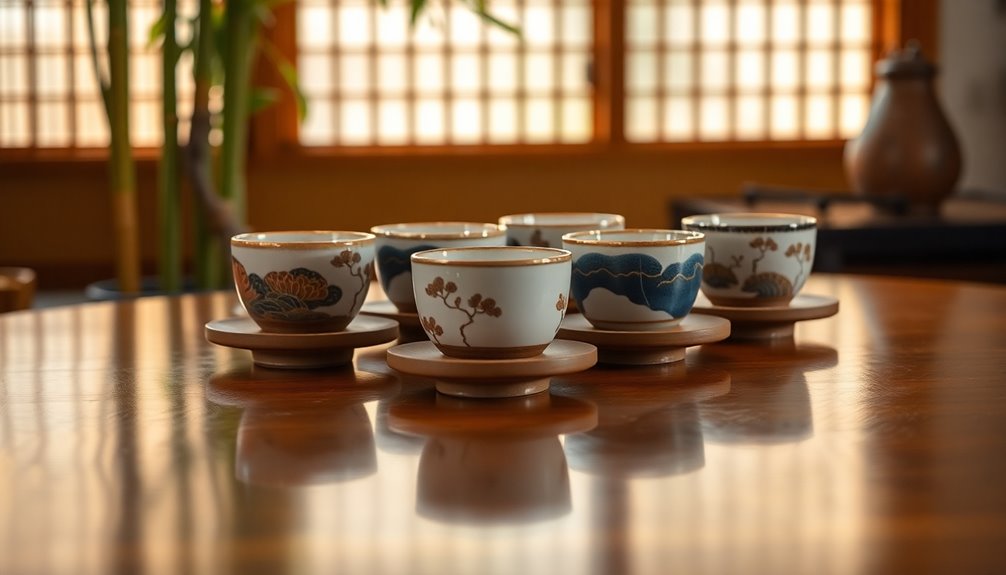
When you explore Japanese teaware, you'll discover that it plays an essential role in the traditional tea ceremony, seamlessly blending aesthetics with functionality.
Each Japanese tea set is carefully designed to enhance your experience, particularly when serving matcha or loose-leaf green teas. You'll find various tea cups, like yunomi for everyday use, chawan for matcha, and senchawan for sencha, each crafted to elevate the flavors of the tea.
The materials, often ceramic or porcelain, reflect the wabi-sabi philosophy, celebrating simplicity and natural imperfections. Skilled artisans create unique pieces that contribute to the beauty of the art of tea.
Seasonal themes and specific tea types influence your choice of teaware, highlighting mindfulness and appreciation deeply rooted in Japanese culture.
Essential Components of Tea Sets
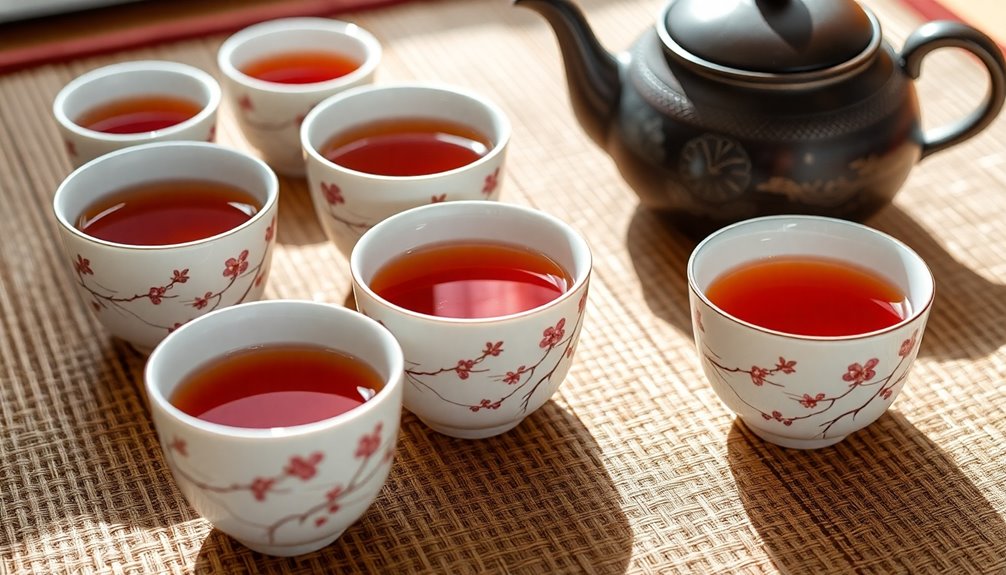
A well-crafted Japanese tea set is vital for an authentic tea ceremony experience, featuring several essential components that enhance both preparation and enjoyment.
Each piece serves a specific purpose, contributing to the overall ritual:
- Chawan: The tea bowl, which influences the flavor of matcha and varies in shape for usucha and koicha.
- Chasen: A bamboo whisk, essential for mixing matcha powder and water, creating that frothy texture.
- Chashaku: A bamboo scoop used to measure the perfect amount of matcha, ensuring consistency in your brew.
- Kensui: The waste water bowl that maintains hygiene, collecting any used water from rinsing utensils during the tea ceremony.
These components work together harmoniously, elevating your tea experience.
Varieties of Japanese Tea Sets

When exploring Japanese tea sets, you'll notice a fascinating mix of traditional and modern designs.
Each set showcases unique materials and craftsmanship that reflect both cultural heritage and contemporary aesthetics.
This variety not only enhances your tea experience but also connects you to the rich history behind these beautiful artifacts.
Traditional vs. Modern Designs
While traditional Japanese tea sets embody the essence of craftsmanship and the wabi-sabi philosophy, modern designs bring a fresh perspective that resonates with contemporary aesthetics.
You'll find that:
- Traditional pieces often showcase handcrafted ceramics with earthy glazes, emphasizing simplicity.
- Modern sets feature sleek lines and vibrant colors, appealing to diverse tastes.
- The Chawan tea bowl varies in shape; traditional bowls focus on depth for whisking matcha, while modern versions highlight artistic designs.
- Materials like cast iron in modern sets offer durability and heat retention, enhancing the tea experience.
This contrast between traditional and modern tea sets reflects the evolving practices surrounding tea drinking in Japan, balancing historical significance with contemporary innovation.
Material and Craftsmanship Variations
Exploring the variety of materials used in Japanese tea sets reveals how each contributes to the overall tea-drinking experience.
You'll find that ceramics often embrace the wabi-sabi philosophy, celebrating imperfections and natural textures. In contrast, porcelain sets charm with their delicate designs and smooth finishes.
If you're drawn to Tokoname tea sets, you'll appreciate their unglazed pottery that retains heat exceptionally well, making them perfect for green teas.
Cast iron tea sets offer durability and excellent heat retention, ideal for brewing hojicha and other robust teas while providing a rustic aesthetic.
The craftsmanship behind these tea sets is meticulous, resulting in unique variations that reflect the artisan's skill and individual style, adding depth to your tea ritual.
Cultural Significance of Tea Ceremonies

The Japanese tea ceremony, known as chanoyu, serves as a profound expression of cultural values, intertwining harmony, respect, purity, and tranquility into each meticulously crafted moment.
Rooted in Zen Buddhism, this ceremony emphasizes mindfulness and simplicity, where every step fosters a spiritual connection among participants.
Key elements contributing to its cultural significance include:
- Attention to Detail: Every utensil and gesture reflects deep respect.
- Seasonal Influence: Teas and decor change with the seasons, symbolizing life's transience.
- Philosophical Foundations: Influenced by figures like Sen no Rikyu, highlighting wabi-sabi aesthetics.
- Ceremonial Grade Matcha: Central to the tea ceremony, enhancing the experience of taste and connection.
Embracing these aspects, you truly appreciate the depth of Chado or Sado.
Luxury Japanese Tea Sets

Luxury Japanese tea sets offer a stunning blend of artistry and functionality, enchanting anyone who appreciates the delicate nuances of tea culture. These exquisite pieces often feature high-quality materials like fine porcelain and cast iron, making them ideal for brewing high-quality teas during tea ceremonies. By exploring the world of luxury Japanese tea sets, you'll discover intricate designs that reflect the art of the Japanese, from floral motifs to modern styles. Each set elevates your tea experience, serving as both a practical tool and a beautiful art piece.
| Feature | Description |
|---|---|
| Material | Fine porcelain, cast iron |
| Design | Traditional and contemporary |
| Functionality | Optimizes heat retention |
| Aesthetic Value | Enhances presentation |
| Ideal for | Gifts and collectors |
Buying Japanese Teaware Online
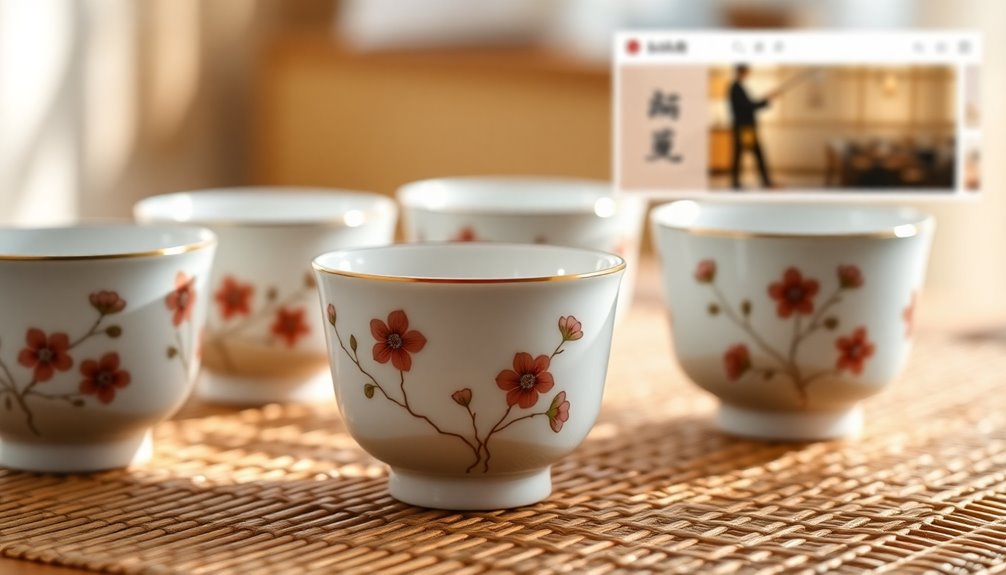
When you're buying Japanese teaware online, it's essential to choose reputable retailers that focus on authentic products.
Pay attention to product descriptions and customer reviews to guarantee you're getting quality craftsmanship and the right materials for your needs.
Also, consider the variety of styles available and check shipping policies to make your purchase experience smooth.
Selecting Quality Teaware Online
Finding quality Japanese teaware online can be a rewarding experience if you know what to look for. Here are some key tips to guarantee you select the best options for your Japanese tea ceremony:
- Authenticity: Purchase from reputable retailers who specialize in Japanese ceramics and teaware.
- Materials: Read product descriptions to understand if the cups are made from porcelain, stoneware, or cast iron, as each influences tea flavor and heat retention.
- Design: Consider the size and shape of the cups, like yunomi or chawan, to enhance your matcha or sencha experience.
- Aesthetics: Look for teaware that reflects traditional motifs and the wabi-sabi philosophy, enriching both beauty and mindfulness in your tea ritual.
Considerations for Online Purchase
How can you guarantee a smooth experience when buying Japanese teaware online? First, verify the seller specializes in traditional Japanese tea sets and offers detailed product descriptions and images.
Pay attention to the materials, like ceramic or porcelain, since they can enhance your tea experience. Customer reviews are invaluable; they'll help you gauge the quality of the teaware and the seller's service.
Before making a purchase, check the return policies—reputable sellers often provide options for returns or exchanges if the product doesn't meet your expectations.
Finally, consider shipping options and costs, especially for delicate items like teapots and tea bowls, to avoid damage during transit.
With these tips, you'll enjoy a satisfying online shopping experience.
Understanding the Tea Ceremony

The Japanese tea ceremony, or chanoyu, immerses you in a rich tradition that emphasizes harmony, respect, purity, and tranquility.
This intimate experience typically accommodates four people and focuses on the preparation and serving of matcha. You'll appreciate the mindful appreciation of tea's qualities, all while adhering to traditional etiquette.
During the ceremony, you can expect to engage with:
- Carefully prepared matcha served from a chawan (tea bowl)
- The graceful use of tea utensils like the chasen (whisk)
- An environment that fosters connection and gratitude among guests
- The beauty and purpose of each tea tool enhancing the ritual
In this serene setting, guests enjoy a deeper connection to both the tea and each other.
Rituals and Etiquette of Tea
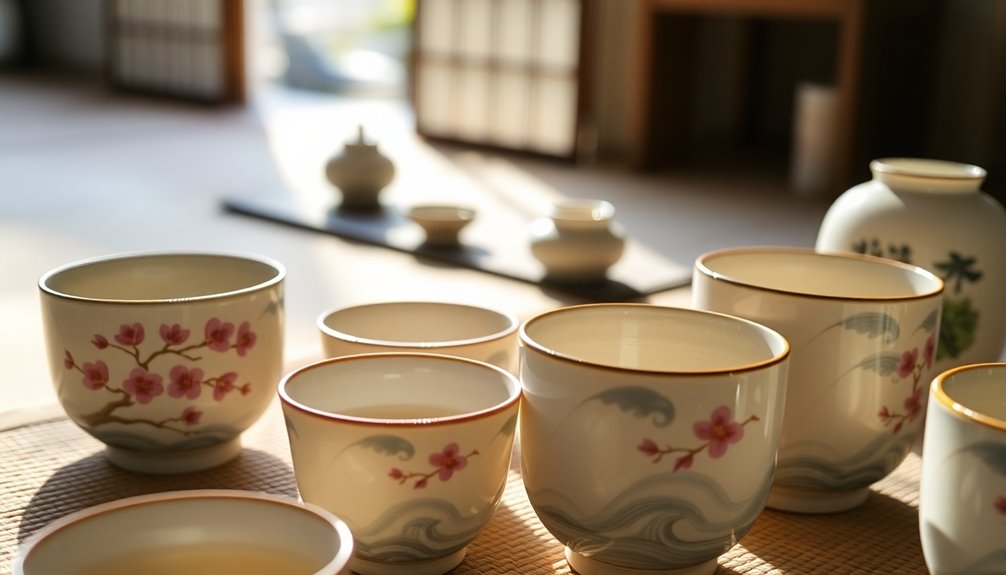
While participating in the Japanese tea ceremony, you'll discover that rituals and etiquette are essential for creating a meaningful experience.
In chanoyu, the host prepares the tea, while guests appreciate the beauty of the tea bowl and the surrounding environment. It's important for you, as a guest, to express gratitude and admiration for the utensils, fostering respect throughout the ceremony.
Proper etiquette dictates that you receive the tea bowl with your right hand, holding it in your left palm, and rotate it before sipping—this shows appreciation for its artistry. After drinking, wipe the rim and return the bowl to the host with the front facing them.
Embrace silence and mindfulness, focusing on the flavors and aromas, enhancing your experience.
Aesthetic Values in Teaware Design

In the serene atmosphere of the Japanese tea ceremony, the aesthetic values of teaware design come to life, enriching your experience. Influenced by the philosophy of wabi-sabi, these designs celebrate beauty in imperfection and simplicity.
Here are key elements that enhance your appreciation:
- Natural Materials: Teaware often utilizes ceramic, porcelain, and bamboo, reflecting the environment.
- Handcrafted Uniqueness: Each piece, like the chawan, showcases the artisan's skill and individual expression.
- Organic Shapes: Designs mimic nature's forms, fostering a sense of tranquility and mindfulness.
- Minimalistic Patterns: Subtle colors and patterns emphasize the tea itself, creating a focused experience.
Embracing these aesthetic values creates a deeper connection to the ritual and the tea you savor.
Frequently Asked Questions
What Are the 4 Principles of Japanese Tea Ceremony?
The four principles of the Japanese tea ceremony are harmony, respect, purity, and tranquility.
You create harmony by fostering a balanced environment where nature and people coexist.
Respect means you acknowledge everyone's presence and the tea itself.
Purity involves cleansing your utensils and mind, ensuring a focused experience.
Finally, tranquility allows you to appreciate the moment, promoting calmness and mindfulness during the tea preparation and consumption.
These principles guide your interactions throughout the ceremony.
What Are 5 Steps in a Japanese Tea Ceremony?
You might think a Japanese tea ceremony is just about drinking tea, but it's much more than that.
First, the host prepares and presents the tea with respect.
Next, you'll admire the beauty of the utensils, fostering appreciation.
Then, you savor the tea's aroma and flavor while engaging in quiet conversation.
Afterward, the host cleans the utensils, signaling the ceremony's end.
Each step emphasizes harmony, respect, purity, and tranquility, enriching the entire experience.
What Are the Four Ideas in the Japanese Tea Ceremony?
In the Japanese tea ceremony, you'll find four key ideas: harmony, respect, purity, and tranquility.
Harmony guides your interactions and the arrangement of the space, creating a peaceful atmosphere.
Respect shows in your thoughtful actions and appreciation for the tea and utensils.
Purity emphasizes cleanliness, ensuring everything is free from impurities.
Finally, tranquility allows you to immerse yourself in a calm moment, providing a break from the chaos of everyday life.
What Are Traditional Japanese Tea Cups Called?
Traditional Japanese tea cups are called yunomi. These cylindrical, handleless cups are perfect for enjoying everyday green teas like sencha.
If you’re looking for something more delicate, consider using a senchawan, which enhances the appreciation of the tea’s qualities. When planning your tea party, it’s important to consider the small details such as the type of teaware you will be using. A senchawan, or Japanese tea cup, is usually smaller and more delicate than a traditional teacup, which can add a touch of elegance to your event. In addition to choosing the perfect teaware, be sure to consult a tea party planning checklist to make sure you haven’t overlooked any important details. This will help ensure that your tea party is a success and that you have everything you need to create a memorable experience for your guests.
For brewing high-quality teas, a hōhin teapot paired with smaller cups is ideal.
Don't forget about ochoko, small cups often used for sake, that can elevate your tea experience.
Conclusion
In exploring Japanese teaware, you've uncovered not just functional items, but pieces of art steeped in tradition. Did you know that about 80% of Japanese tea ceremonies emphasize mindfulness and respect? This statistic highlights the profound cultural significance behind each cup and ritual. As you appreciate the beauty and craftsmanship of these sets, you're also participating in a rich heritage that fosters connection and tranquility. Embrace the experience, and let each sip transport you to Japan's serene landscapes.
